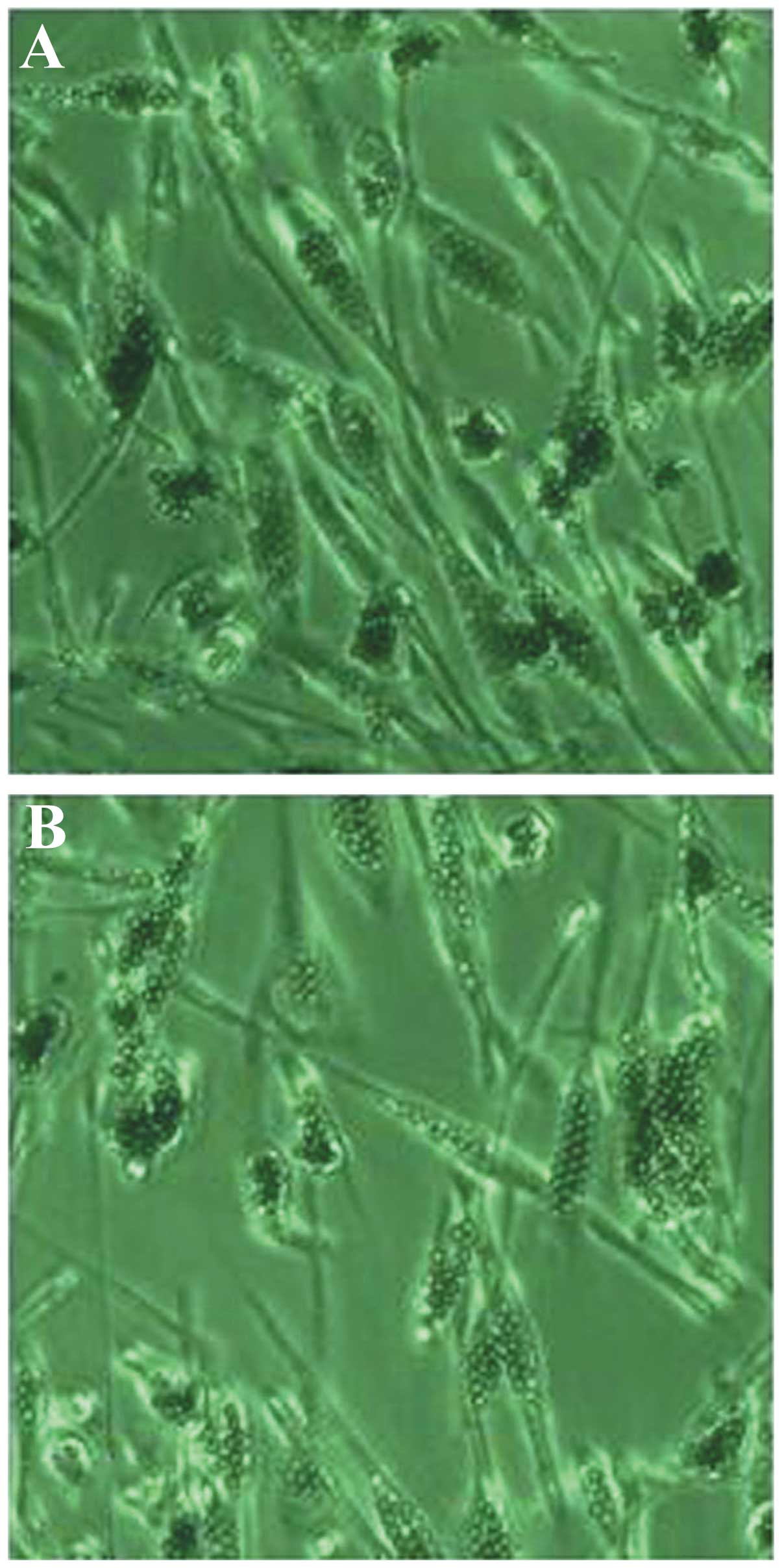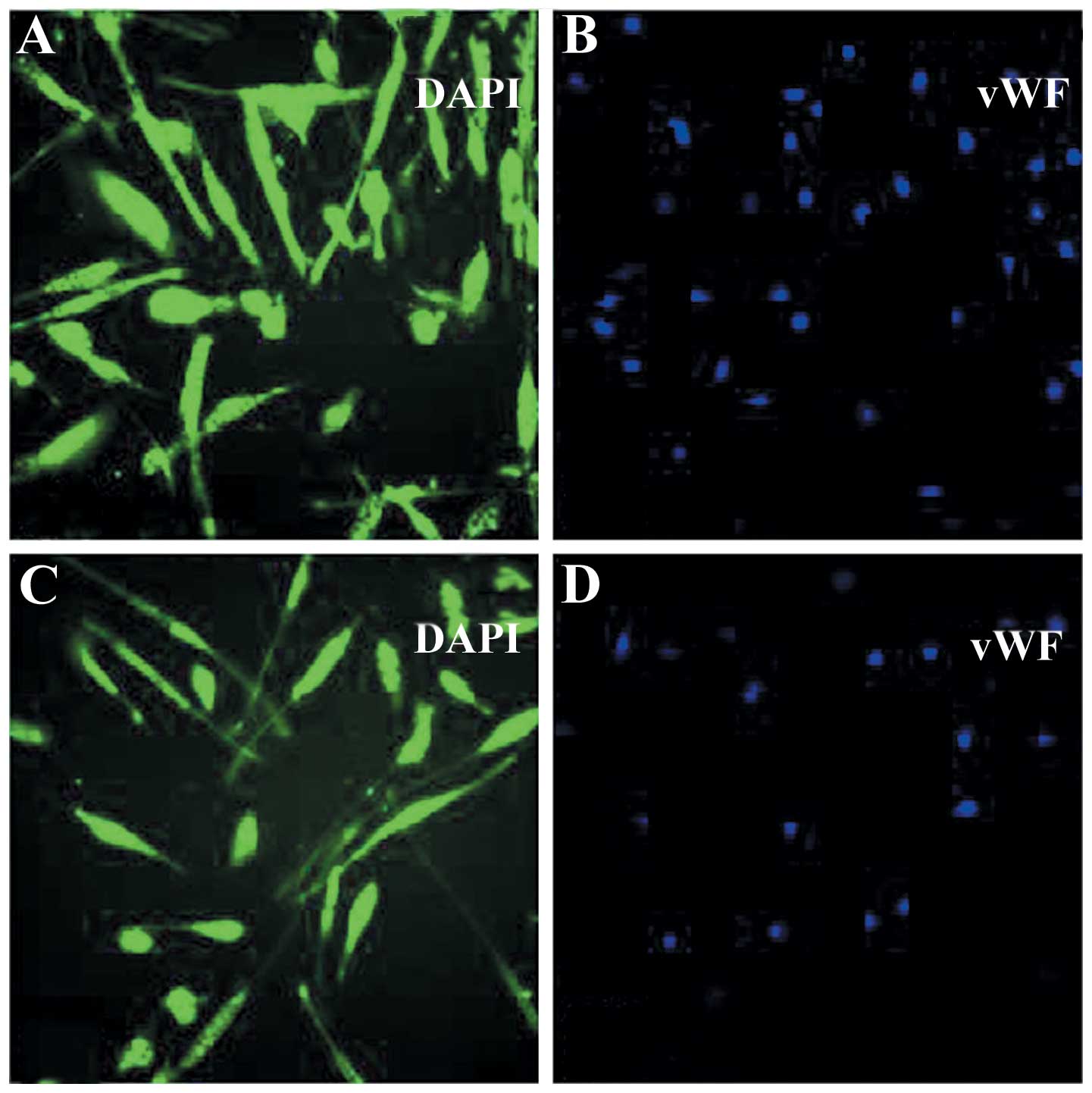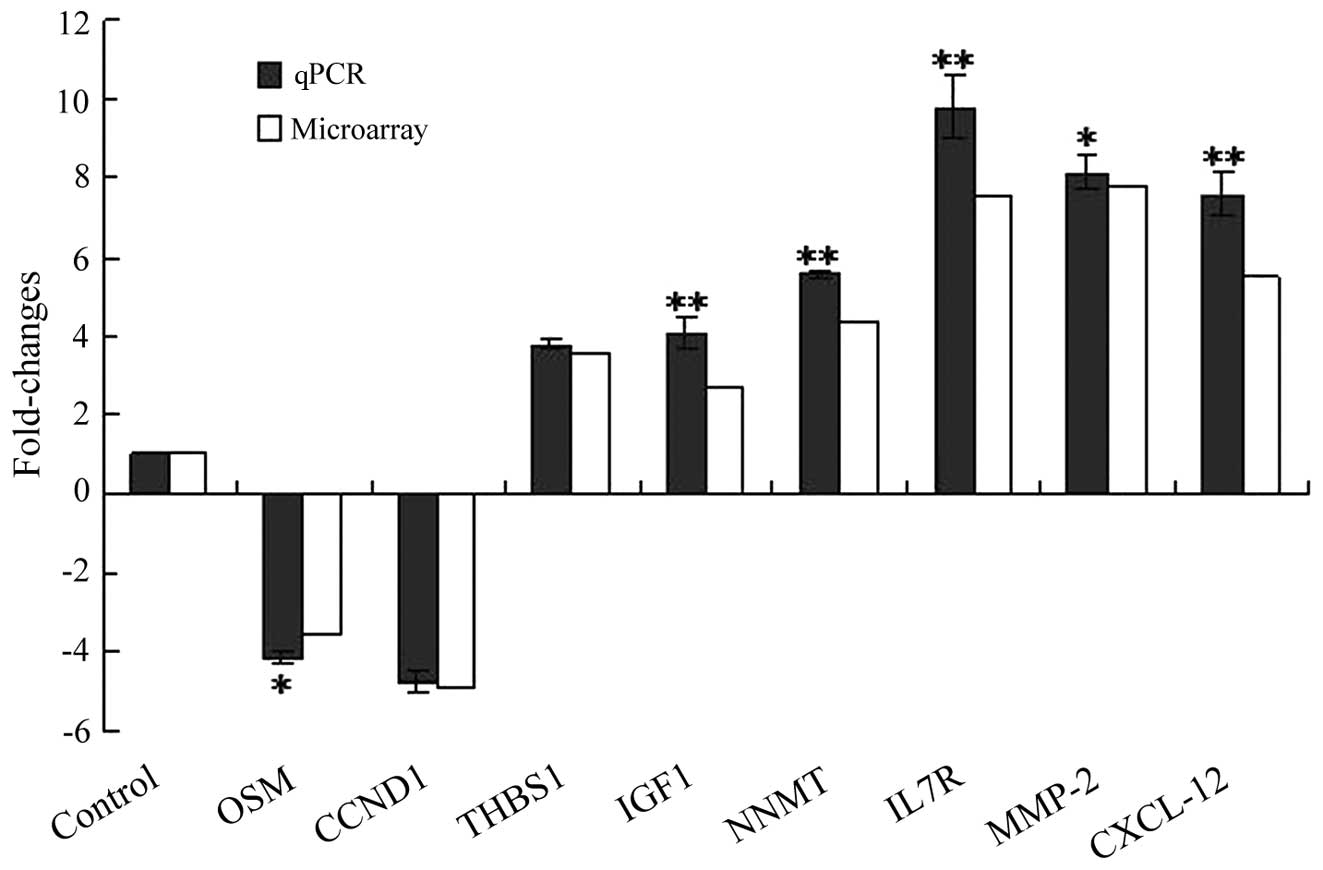|
1
|
Folkman J: What is the evidence that
tumors are angiogenesis dependent? J Natl Cancer Inst. 82:4–6.
1990. View Article : Google Scholar : PubMed/NCBI
|
|
2
|
Carmeliet P and Jain RK: Angiogenesis in
cancer and other diseases. Nature. 407:249–257. 2000. View Article : Google Scholar : PubMed/NCBI
|
|
3
|
Folkman J: Angiogenesis in cancer,
vascular, rheumatoid and other disease. Nat Med. 1:27–31. 1995.
View Article : Google Scholar : PubMed/NCBI
|
|
4
|
Fuks Z and Kolesnick R: Engaging the
vascular component of the tumor response. Cancer Cell. 8:89–91.
2005. View Article : Google Scholar : PubMed/NCBI
|
|
5
|
Cooper BC, Ritchie JM, Broghammer CL, et
al: Preoperative serum vascular endothelial growth factor levels:
significance in ovarian cancer. Clin Cancer Res. 8:3193–3197.
2002.PubMed/NCBI
|
|
6
|
Davis GE and Senger DR: Endothelial
extracellular matrix: biosynthesis, remodeling, and functions
during vascular morphogenesis and neovessel stabilization. Circ
Res. 97:1093–1107. 2005. View Article : Google Scholar
|
|
7
|
Hu Z, Lin D, Yuan J, et al: Overexpression
of osteopontin associated with more aggressive phenotypes in human
non-small cell lung cancer. Clin Cancer Res. 11:4646–4652. 2005.
View Article : Google Scholar : PubMed/NCBI
|
|
8
|
Eto M, Kodama S, Nomi N, Uemura N and
Suzuki M: Clinical significance of elevated ostopontin levels in
head and neck cancer patients. Auris Nasus LaryU. 34:343–346. 2007.
View Article : Google Scholar : PubMed/NCBI
|
|
9
|
Kerbel R and Folkman J: Clinical
translation of angiogenesis inhibitors. Nat Rev Cancer. 2:727–739.
2002. View
Article : Google Scholar : PubMed/NCBI
|
|
10
|
Lu C, Bonome T, Li Y, Kamat AA, et al:
Gene alterations identified by expression profiling in
tumor-associated endothelial cells from invasive ovarian carcinoma.
Cancer Res. 67:1757–1768. 2007. View Article : Google Scholar : PubMed/NCBI
|
|
11
|
Peltenburg LT: Radiosensitivity of tumor
cells. Oncogenes and apoptosis Q. J Nucl Med. 44:355–364.
2000.PubMed/NCBI
|
|
12
|
Du XL, Jiang T, Zhao WB, et al: Gene
alterations in tumor-associated endothelial cells from endometrial
cancer. Int J Mol Med. 22:619–632. 2008.PubMed/NCBI
|
|
13
|
Livak KJ and Schmittgen TD: Analysis of
relative gene expression data using real-time quantitative PCR and
the 2(-Delta Delta C(T)) Method. Methods. 25:402–408. 2001.
View Article : Google Scholar : PubMed/NCBI
|
|
14
|
Kufe D and Weichselbaum R: Radiation
therapy: activation for gene transcription and the development of
genetic radiotherapy-therapeutic strategies in oncology. Cancer
Biol Ther. 2:326–329. 2003. View Article : Google Scholar : PubMed/NCBI
|
|
15
|
Raman D, Baugher PJ, Thu YM and Richmond
A: Role of chemokines in tumor growth. Cancer Lett. 256:137–165.
2007. View Article : Google Scholar : PubMed/NCBI
|
|
16
|
Wolff HA, Rolke D, Rave-Fränk M, et al:
Analysis of chemokine and chemokine receptor expression in squamous
cell carcinoma of the head and neck (SCCHN) cell lines. Radiat
Environ Biophys. 50:145–154. 2011. View Article : Google Scholar : PubMed/NCBI
|
|
17
|
Kryczek I, Wei S, Keller E, Liu R and Zou
W: Stroma-derived factor (SDF-1/CXCL12) and human tumor
pathogenesis. Am J Physiol Cell Physiol. 292:C987–C995. 2007.
View Article : Google Scholar : PubMed/NCBI
|
|
18
|
Chang CC, Lerman OZ, Thanik VD, et al:
Dose-dependent effect of radiation on angiogenic and angiostatic
CXC chemokine expression in human endothelial cells. Cytokine.
48:295–302. 2009. View Article : Google Scholar : PubMed/NCBI
|
|
19
|
Hu X, Li D, Zhang W, et al: Matrix
metalloproteinase-9 expression correlates with prognosis and
involved in ovarian cancer cell invasion. Arch Gynecol Obstet.
286:1537–1543. 2012. View Article : Google Scholar : PubMed/NCBI
|
|
20
|
Peng F, Xu Z, Wang J, et al: Recombinant
human endostatin normalizes tumor vasculature and enhances
radiation response in xenografted human nasopharyngeal carcinoma
models. PLoS One. 7:e346462012. View Article : Google Scholar
|
|
21
|
Pratheeshkumar P and Kuttan G: Vernolide-A
inhibits radiation-induced hypoxia-mediated tumor angiogenesis by
regulating HIF-1α, MMP-2, MMP-9, and VEGF. J Environ Pathol Toxicol
Oncol. 30:139–151. 2011.PubMed/NCBI
|
|
22
|
Badiga AV, Chetty C, Kesanakurti D, et al:
MMP-2 siRNA inhibits radiation-enhanced invasiveness in glioma
cells. PLoS One. 6:e206142011. View Article : Google Scholar : PubMed/NCBI
|
|
23
|
Kaliski A, Maggiorella L, Cengel KA, et
al: Angiogenesis and tumor growth inhibition by a matrix
metalloproteinase inhibitor targeting radiation-induced invasion.
Mol Cancer Ther. 4:1717–1728. 2005. View Article : Google Scholar : PubMed/NCBI
|
|
24
|
Nilsson MB, Langley RR and Fidler IJ:
Interleukin-6, secreted by human ovarian carcinoma cells, is a
potent proangiogenic cytokine. Cancer Res. 65:10794–10800. 2005.
View Article : Google Scholar : PubMed/NCBI
|
|
25
|
Lo CW, Chen MW, Hsiao M, et al: IL-6
trans-signaling in formation and progression of malignant ascites
in ovarian cancer. Cancer Res. 71:424–434. 2011. View Article : Google Scholar : PubMed/NCBI
|
|
26
|
Duan Z, Foster R, Bell DA, et al: Signal
transducers and activators of transcription 3 pathway activation in
drug-resistant ovarian cancer. Clin Cancer Res. 12:5055–5063. 2006.
View Article : Google Scholar : PubMed/NCBI
|
|
27
|
Oh ET, Park MT, Song MJ, et al:
Radiation-induced angiogenic signaling pathway in endothelial cells
obtained from normal and cancer tissue of human breast. Oncogene.
Mar 18–2013.(Epub ahead of print).
|
|
28
|
Yu YC, Yang PM, Chuah QY, et al:
Radiation-induced senescence in securin-deficient cancer cells
promotes cell invasion involving the IL-6/STAT3and PDGF-BB/PDGFR
pathways. Sci Rep. 3:16752013.PubMed/NCBI
|
|
29
|
Rofstad EK, Henriksen K, Galappathi K and
Mathiesen B: Antiangiogenic treatment with thrombospondin-1
enhances primary tumor radiation response and prevents growth of
dormant pulmonary micrometastases after curative radiation therapy
in human melanoma xenografts. Cancer Res. 63:4055–4061. 2003.
|
|
30
|
Maxhimer JB, Soto-Pantoja DR, Ridnour LA,
et al: Radioprotection in normal tissue and delayed tumor growth by
blockade of CD47 signaling. Sci Transl Med. 1:3ra72009.PubMed/NCBI
|
|
31
|
Liebmann J, DeLuca AM, Coffin D, et al: In
vivo radiation protection by nitric oxide modulation. Cancer Res.
54:3365–3368. 1994.PubMed/NCBI
|
|
32
|
Isenberg JS, Martin-Manso G, Maxhimer JB
and Roberts DD: Regulation of nitric oxide signalling by
thrombospondin 1: implications for anti-angiogenic therapies. Nat
Rev Cancer. 9:182–194. 2009. View
Article : Google Scholar : PubMed/NCBI
|
|
33
|
Kwon M, Hanna E, Lorang D, et al:
Functional characterization of filamin a interacting protein
1-like, a novel candidate for antivascular cancer therapy. Cancer
Res. 68:7332–7341. 2008. View Article : Google Scholar : PubMed/NCBI
|
|
34
|
Lu H and Hallstrom TC: Sensitivity to TOP2
targeting chemotherapeutics is regulated by Oct1 and FILIP1L. PLoS
One. 7:e429212012. View Article : Google Scholar : PubMed/NCBI
|
|
35
|
Aksoy S, Szumlanski CL and Weinshilboum
RM: Human liver nicotinamide N-methyltransferase cDNA cloning,
expression, and biochemical characterization. J Biol Chem.
269:14835–14840. 1994.PubMed/NCBI
|
|
36
|
Sun LQ, Coucke PA, Mirimanoff RO and
Buchegger F: Fractionated irradiation combined with carbogen
breathing and nicotinamide of two human glioblastomas grafted in
nude mice. Radiat Res. 155:26–31. 2001. View Article : Google Scholar : PubMed/NCBI
|
|
37
|
Hoskin PJ, Saunders MI, Phillips H, et al:
Carbogen and nicotinamide in the treatment of bladder cancer with
radical radiotherapy. Br J Cancer. 76:260–263. 1997. View Article : Google Scholar : PubMed/NCBI
|
|
38
|
Kassem HSh, Sangar V, Cowan R, Clarke N
and Margison GP: A potential role of heat shock proteins and
nicotinamide N-methyl transferase in predicting response to
radiation in bladder cancer. Int J Cancer. 101:454–460. 2002.
View Article : Google Scholar : PubMed/NCBI
|












